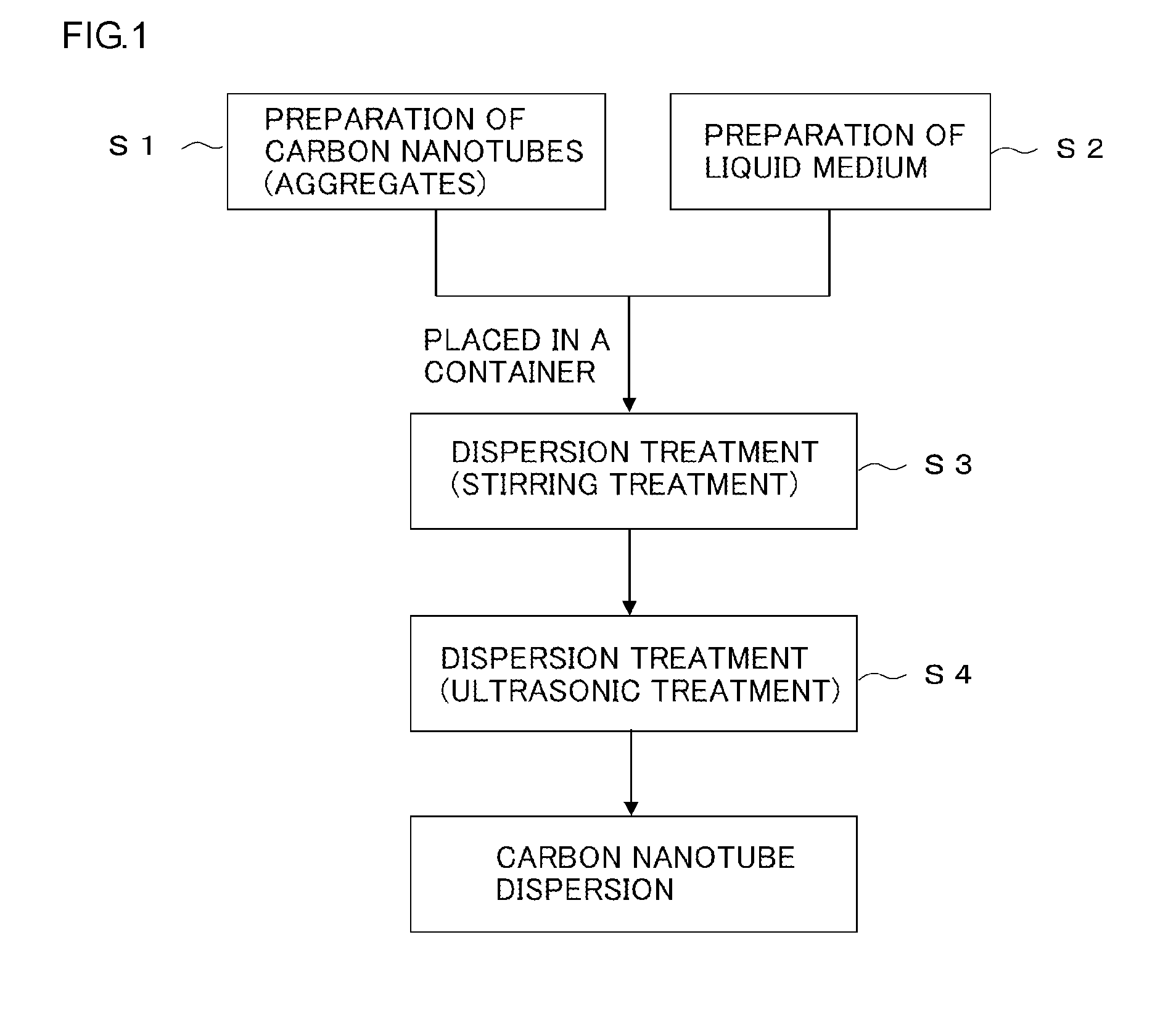Carbon nanotube dispersion and utilization of same
- Summary
- Abstract
- Description
- Claims
- Application Information
AI Technical Summary
Benefits of technology
Problems solved by technology
Method used
Image
Examples
experimental example 1
[0070]A carbon nanotube dispersion was produced according to the procedure shown in FIG. 1. First, carbon nanotube aggregates were prepared by various methods (such as arc discharge) for use as a raw material (Step S1). In the present experimental example, the carbon nanotube aggregates were prepared in the manner described below.
[0071]Namely, a pair of stick-shaped electrodes (cathode and anode) were prepared that were composed of graphite-containing iron (0.5 mol % to 5 mol %), and the electrodes were arranged in mutual opposition in a reaction vessel at a spacing of about 0.5 mm to 5 mm. The inside of the reaction vessel was adjusted to an atmosphere at a hydrogen gas (H2) partial pressure of 1.3×104 Pa and an inert gas (in this case, argon (Ar)) partial pressure of about 1.3×104 Pa. A voltage of about 20 V to 40 V was applied between the pair of electrodes from a direct current power supply, a current of about 30 A to 70 A was supplied from the power supply, and an arc discharge...
experimental example 2
[0079]Next, a liquid medium not containing polyvinyl butyral resin was prepared (namely, a liquid medium containing only ethanol). A carbon nanotube dispersion was produced in the same manner as Experimental Example 1 with the exception of not containing polyvinyl butyral resin as described above. As a result, although carbon nanotube aggregates were initially dispersed in the resulting dispersion, they soon settled and a dispersed state was unable to be maintained. An SPM micrograph of this dispersion is shown in FIG. 4, while an optical photograph thereof is shown in FIG. 5.
experimental example 3
[0080]Next, the ethanol used for the alcohol solvent in the liquid medium was changed to commercially-available absolute methanol (purity: 99.9%). A carbon nanotube dispersion was produced in the same manner as Experimental Example 1 with the exception of using the above-mentioned methanol instead of ethanol. The resulting dispersion was then allowed to stand undisturbed. An optical photograph of the dispersion after being allowed to stand undisturbed for 2 weeks is shown in FIG. 6. As is clear from this micrograph, there was no settling of carbon nanotube aggregates and a satisfactory dispersed state was confirmed to be maintained even after being allowed to stand undisturbed for 2 weeks.
PUM
| Property | Measurement | Unit |
|---|---|---|
| Temperature | aaaaa | aaaaa |
| Length | aaaaa | aaaaa |
| Length | aaaaa | aaaaa |
Abstract
Description
Claims
Application Information
 Login to View More
Login to View More - R&D
- Intellectual Property
- Life Sciences
- Materials
- Tech Scout
- Unparalleled Data Quality
- Higher Quality Content
- 60% Fewer Hallucinations
Browse by: Latest US Patents, China's latest patents, Technical Efficacy Thesaurus, Application Domain, Technology Topic, Popular Technical Reports.
© 2025 PatSnap. All rights reserved.Legal|Privacy policy|Modern Slavery Act Transparency Statement|Sitemap|About US| Contact US: help@patsnap.com



